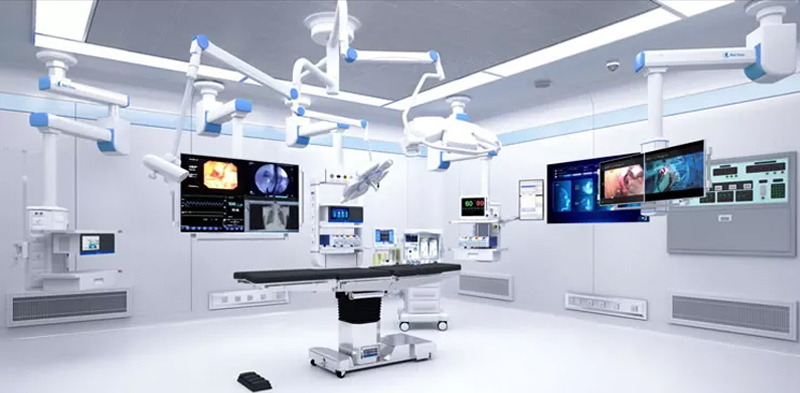

In modern surgical settings, efficiency, precision, and patient safety are paramount. So, to achieve these goals, various technological advancements have been integrated into operating rooms. Surgical boom is one of these advanced operating room integrations. A versatile equipment system designed to enhance workflow, optimize space utilization, and improve patient outcomes.

What is a Surgical Boom?
Surgical booms are generally used within healthcare facilities that need easy access to electrical power and audio-visual data services as well as medical gases such as oxygen, nitrogen, and carbon dioxide.
Purpose Of Surgical Booms
A surgical boom is a ceiling-mounted equipment management system. It houses various surgical instruments, monitors, and utilities required during surgical procedures. It serves as a centralized hub, facilitating the organization and easy access of tools and equipment for surgical teams. However, the primary purpose of a surgical boom is to enhance efficiency, ergonomics, and safety by eliminating clutter and optimizing workspace utilization.
Surgical Boom Configurations & Space Requirements
Surgical Booms are often designed to be flexible and able to conform to various configurations depending on the space requirements, function and purpose. Factors such the type of surgical procedures, interaction with equipment, and layout of the room (Operating Room, Intensive Care Unit (ICU), Emergency Room, etc.) must be considered when designing a surgical boom. A surgical boom often contains multiple electric and gas outlets for electrical power needs and medical gases. Ceiling mount location, the number of mounts, arm length, and column length are all variables that must be selected to ensure proper integration of the surgical boom into the perioperative workspace.
Surgical Boom Accessories
A surgical boom can be used with hundreds of accessories such as equipment shelves, equipment rails and rail mounted accessories, smoke evacuation system, IV support, medical gas support, monitor arms and organizational tools.
Equipment shelves – Surgical equipment such as cameras, insufflation, and electrosurgical units (ESUs) are often placed on shelves attached to the surgical boom. The size and weight capacity of the shelves must be sufficient to support anticipated equipment requirements.
Equipment rails and rail mounted accessories – Some surgical equipment can be mounted to rails attached to the surgical boom.
Smoke evacuation system – Designed to remove or filter smoke and aerosols produced from a surgical site during electrosurgical and laser procedures.
IV support – The surgical boom should support mounting of various IV poles.
Monitor arms – Monitors are often mounted to the surgical boom to display patient information or video from within the operative site.
Organizational tools – Baskets, drawers and computer stations are just a few examples of organizational items that can be added to a surgical boom.
Installation Requirements
The installation of surgical booms requires significant planning and knowledge to meet structural requirements and ensure proper connection to electrical and gas utilities. Most surgical booms are installed as part of a renovation project or during construction of new surgical suites, and room layouts and other factors are considered when selecting surgical boom systems.
Conclusion
Surgical booms have revolutionized the way surgical teams operate, providing a streamlined and efficient environment for procedures. So, with their ergonomic advantages, enhanced workflow, and improved space utilization, surgical booms contribute to better patient care and outcomes. As technology continues to advance, surgical booms are expected to evolve further, incorporating additional features to meet the ever-changing needs of the surg